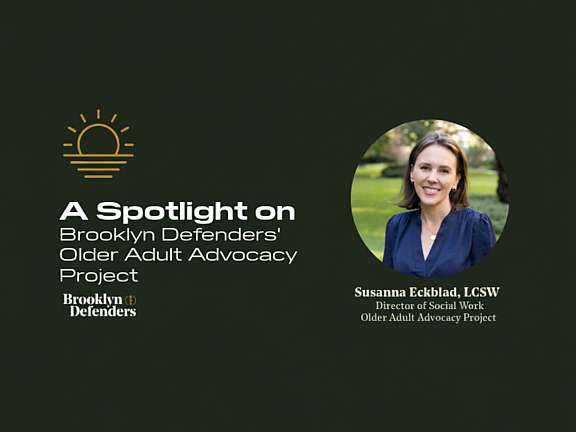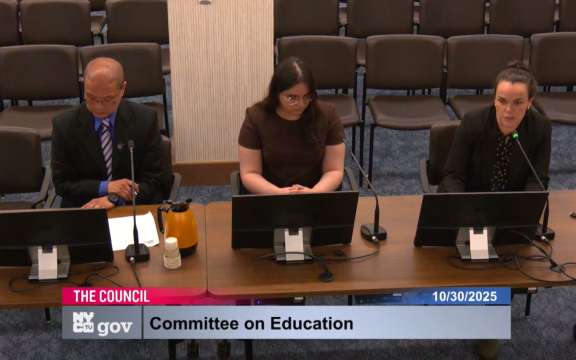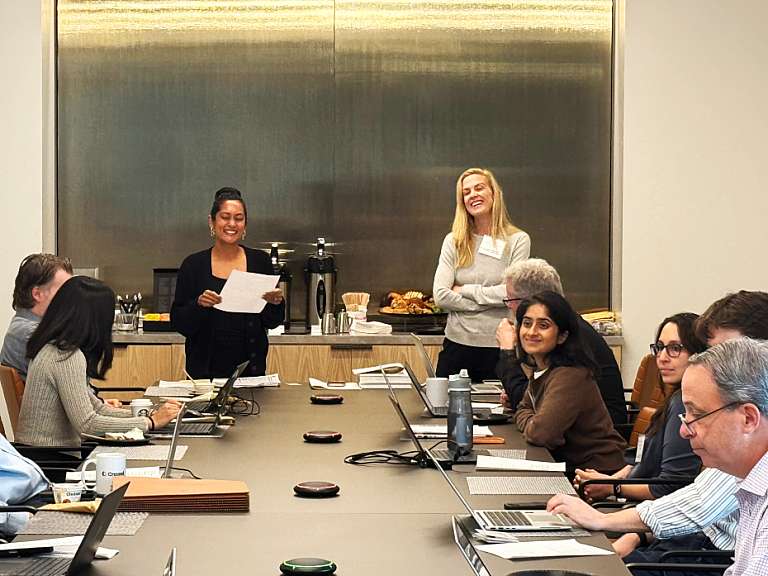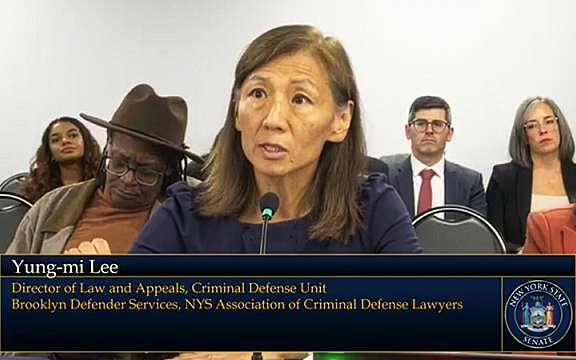Spotlight: Brooklyn Defenders’ Older Adult Advocacy Project

A Spotlight on Brooklyn Defenders’ Older Adult Advocacy Project
Older adults are one of the fastest-growing populations affected by policing and prosecution in New York and they are facing a legal system that often overlooks their unique needs, especially when the collateral consequences of criminal charges threaten their health, stability, and connection to the community. In this Q&A, BDS Director of Social Work Susanna Eckblad, who leads our Older Adult Advocacy Project, explains how aging New Yorkers are increasingly caught in a web of criminalization and bureaucratic hurdles, and shares how BDS is fighting to keep its elder clients supported, housed, and free.
Q: What makes BDS' Older Adult Advocacy Project so urgent and essential at this moment? What gaps in legal or social services does it aim to fill for older New Yorkers?
As a country and as a city, we are aging. The proportion of older adults in the U.S. has been steadily increasing and is projected to keep growing for the next several decades. Adults aged 65 and older made up 16.8% of the population in 2020 and will make up 23% by 2054. In New York City right now, older adults make up 20% of our population. Although many legal resources exist for older adults in areas like estate planning, elder abuse, and legal issues related to benefits, the specialized needs of older adult defendants in criminal court have not been given special attention. The Older Adult Advocacy Project at BDS seeks to begin to try to fill that gap.
Q: What are the most common legal challenges older adults face? How do those challenges differ from younger clients?
Throughout the course of a criminal court case, many challenges that older adults face are identical to those of younger clients. However, there are certain issues that are more prevalent for older adults. For example, for people who have mobility limitations, it is often much more difficult to get to court or to programming that might be mandated by the court. Chronic medical conditions also become more likely as we age and for those with health issues, pre-trial incarceration at Rikers Island is especially dangerous and difficult. If a person is facing a sentence of prison time, we know that prisons are unequipped to provide high-quality medical care, to put it mildly. Prison itself also increases one’s rate of aging; people face chronic and life-threatening illnesses sooner than expected and physiological signs of aging occur younger than expected. So for an older adult who is already having health struggles, incarceration is going to have an outsized impact and a non-jail outcome is especially medically vital.
There are also common life challenges that are crucial to consider as context. As we age, we experience things like shifts in social and family network (for example, the death of close family members), retirement or a shift in type of employment, caretaking for a loved one, and potential changes in housing situation. All of these will interact with the collateral consequences of a person’s arrest and certainly complicate reentry. Jail and prison are inherently destabilizing and leave a person to start over in so many ways after release. Having to start over when a person has fewer years ahead of them in life to rebuild is an extremely difficult challenge for older adults. A big focus of the Older Adult Advocacy Project is to fight for outcomes that will keep older adults in the community and facilitate more support and more community connection.
Notably, there are many different organizations and programs out there that specifically work with young adults who are dealing with the criminal legal system. There is very little out there specifically for older adults. However, I think we’ll definitely be seeing the emergence of these programs in coming years, as the need continues to grow. Each stage of life brings certain challenges and strengths so this type of age-specific advocacy work is so important.
Q: How does your approach to defending older adults differ from other types of legal advocacy?
This project is housed within our Criminal Defense Social Work unit and so generally the approach is the same for any age: social workers use a client-centered and holistic perspective to gather information on a person’s biopsychosocial history and current life circumstances, and we share this information in written advocacy. We also help connect people with the best resources to fit their needs and preferences.
Where the approach to advocacy for older adults differs is simply that with the establishment of this project, we are developing expertise in the unique needs of this population as well as the resources that exist. We’re steadily learning more about the wide range of topics that affect older adults (for example, various medical conditions, including dementia; different types of senior housing options; navigating Social Security and Medicare). We’re also learning more about the historical events that have shaped people’s lives and should be taken into account to understand the person as they are today. Both general history and also history specifically pertaining to the criminal legal system—a person who’s had past arrests may have been highly impacted by harmful past practices that no longer exist today (for example, past marijuana convictions, Rockefeller Drug Laws, extended stretches in solitary confinement that would now be illegal). There are also a lot of specialized resources for older adults in New York City under the umbrella of the Department for the Aging (DFTA), but learning about all these services is a major learning curve. Historically, geriatric social work has been very separate from criminal defense social work and there needs to be much more cross-training, collaborating, and resource sharing.
Q: What role does BDS’s multidisciplinary structure play in supporting older clients beyond the courtroom?
BDS is so rich with in-house expertise and older clients often work with more units than solely the Criminal Defense Practice. The Civil Justice Practice frequently assists older adults with housing questions and benefits issues. Our Jail Services Unit is constantly providing support to many clients at Rikers and advocating for their health needs. Our Reentry Unit serves many older adult clients both via one-on-one support and through their Reentry Speaks Loud and Clear (RSLC) support group. On a broader level, our Policy & Advocacy Unit has been highly involved in advocating for two critical NY state bills that affect older adults: Enacting Fair and Timely Parole (S497-A/A4346) and Elder Parole (S2144/A9040).
Q: How do the legal challenges older adults face intersect with their racial, gender, or sexual identities?
Racial bias pervades the legal system at every stage and for older adults, one major area where this stands out is in sentencing. For an older person of color who has a past criminal record and is arrested on a new charge, they are often facing a tougher sentence (for example, a mandatory minimum) but their past record has in itself been influenced by the racist policies that have fueled mass incarceration.
In general, for any older adult who has experienced discrimination due to any of these identities, it’s important to consider the weight of how many years they have been impacted. How have structural inequities as well as individual difficult experiences partially led to this person’s risk for legal involvement in the present moment? And what type of outcome in their case could contribute toward fairness and repair?
Q: What kind of impact do you hope this project will have on both clients and broader policy?
I believe the project will lead to more and more older adults staying in the community rather than being sentenced to jail or prison. In addition to better legal outcomes, I also hope the project will connect many people to the right resources to further their goals outside of their case.
On a broader level, this project will allow us to gather data on policy issues that need improvement. There are so many! For example, BDS stocks a supply of canes in criminal court because people’s canes are frequently taken away from them in the course of being arrested. We’re tracking all of these cases so that we can work toward a solution. Another issue is when dementia symptoms lead to an arrest. Truly no one with significant dementia should be arrested—any issues rooted in dementia symptoms belong squarely in the realm of the medical system, not the criminal legal system. However, when someone with dementia does get arrested, how can we resolve the case in the most sensible, least harmful way? Through tracking BDS’ work with clients with dementia, we are gathering information on best practices.
Q: What do you wish more people understood about how aging interacts with policing, prosecution, or incarceration? What are the biggest misconceptions?
I don’t think there are a lot of big misconceptions per se, because I don’t think people are conceiving of these issues much at all. The interaction of aging with policing, prosecution, and incarceration is definitely a topic that has not received enough attention.
If there is one thing that I wish that everyone knew, it’s that the proportion of older adults in prison has been rising at an alarming rate. it is predicted that by 2030 the population of people aged 50 and older is projected to account for one-third of all incarcerated people in the U.S. The rise is not due to new arrests—older adults have a low recidivism rate and a lower likelihood of committing new crimes. Instead it’s due to factors like long sentences and parole denials. Reforms to the parole system are critical in order to reverse this trend and bring aging people back home.
Q: Can you share a case or client story that illustrates the stakes of this work?
A man in his early sixties who we represented recently was suspended from his job as a city employee due to felony charges. He had worked serving the public for his whole adult life and was also a military veteran. Additionally, he was the primary caretaker for his wife who was suffering from terminal illness. The stress of his legal case and job suspension on top of his stress at home was incredibly overwhelming. Due to not being able to work, he was worried he would soon fall behind on rent and face eviction. He was overwhelmed by anxiety, not sleeping, and desperately scared that he would lose a job he loved and relied on as well as his future retirement pension.
His attorney submitted a motion for dismissal in the interest of justice and described how even a misdemeanor charge could potentially bar him from returning to his city job. The motion highlighted many legal problems with the way the purported evidence had been obtained, including questionable issues involving the warrant, consent to search, and much more. It also included a mitigation report describing all of his extraordinary qualities as a person, his long history of employment and civic responsibility, his role as a caretaker, his participation in counseling (where we had referred him and which he was attending for the first time in his life and finding very helpful) as well as some significant health issues that he was experiencing. The motion was extremely successful—he was offered a disorderly conduct charge which would result in no criminal record. His case was closed and he was able to return to work and have a huge weight lifted from him.



